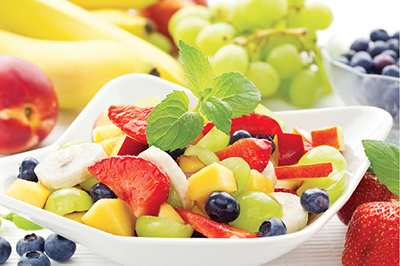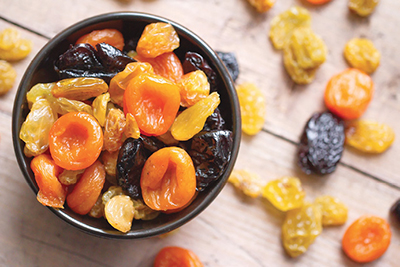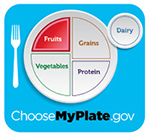MyPlate—The Fruit Group: Focus on Fruits
Guide E-141
Revised by Raquel Garzon
College of Agricultural, Consumer and Environmental Sciences, New Mexico State University
Author: Extension Nutrition and Wellness Specialist, Department of Extension Family and Consumer Sciences, New Mexico State University. (Print Friendly PDF)
Introduction
The fruit group includes all fresh, frozen, canned, and dried fruits. Fruits may be eaten whole, cut up, or puréed, or consumed as 100% fruit juices. Fruits are naturally low in calories, sodium, and fat, and are free of cholesterol. They offer a variety of tastes and textures, and you can add fruits to many foods, such as salads, desserts, breads, and yogurt.

© Inga Nielsen | Dreamstime.com
Eating more fruits as part of a normal healthy eating plan can reduce the risk of some chronic diseases and issues, such as heart disease, certain types of cancers, obesity, type 2 diabetes, kidney stones, and bone loss.
Nutrients in the Fruit Group
The following nutrients are found in most fruits. A typical American diet is at risk for being low in nutrients marked with an asterisk (*).
*Fiber helps reduce blood cholesterol levels, may reduce the risk of heart disease, and promotes proper bowel function, including reducing constipation. Fiber-containing foods such as fruits help provide a feeling of fullness with fewer calories. Whole or cut up fruits are sources of dietary fiber; fruit juices contain little or no fiber.
*Folate helps produce red blood cells and reduces a woman’s risk of having a child with a brain or spinal cord defect.
*Potassium helps maintain a healthy blood pressure and is needed for muscle and nerve function. Some examples of potassium-rich fruits are prune juice, prunes, dried peaches or apricots, bananas, cantaloupe, honeydew melons, orange juice, raisins, figs, and berries.
Vitamin C helps heal cuts and wounds, grow and repair all body tissues, and maintain healthy teeth and gums.
How Many Fruits are Needed?
MyPlate recommends eating between 1 and 2 cups of fruits every day, depending on your age, gender, and level of physical activity (Table 1). For more information, visit www.choosemyplate.gov.
What does one cup from the fruit group mean?
- 1 cup of chopped or whole fruit
- 1/2 cup of dried fruit
- 1 small apple
- 1 cup watermelon
- 1 medium pear
- 1 large banana
- 1 large orange
- 1 large peach
- 2 large plums
- 8 large strawberries
- 32 seedless grapes
- 1 cup (8 ounces) of 100% fruit juice
|
Table 1. Daily Recommendations for the Fruit Group |
||
|
Age |
Cup(s) |
|
|
Children |
2–3 years 4–8 years |
1 1 to 1 1/2 |
|
Girls |
9–18 years |
1 1/2 |
|
Boys |
9–13 years 14–18 years |
1 1/2 2 |
|
Women |
19–30 years 31+ years |
2 1 1/2 |
|
Men |
19–30 years 31+ years |
2 2 |
|
These amounts are appropriate for people who get less than 30 minutes per day of moderate exercise; those who are more physically active may be able to eat more than what is recommended in the table. |
||
Why should you consider choosing fruit instead of juice?
Although 100% fruit juice can be a healthful part of your diet, it is always better to choose more whole fruits than juice because whole fruits contain more fiber. If you need 2 cups of fruit daily, you could select 1 cup of fruit juice and 1 cup of whole fruit.
“Fruit punch,” “fruit aid,” and “fruit drinks” contain little to no actual fruit juice. They are high in sugar and water and lack other nutrients. Read the food label to determine the percentage of juice in the drink. Sweetened juice products with minimal juice content, such as sports and energy drinks, are considered sugar-sweetened beverages rather than fruit juice.
Tips for Buying Fruits
- Buy fresh fruits in season when they have peak flavor and are available at a good price.
- If you decide to buy juices, purchase only 100% fruit juice. Read the label to determine the percentage of juice.
- Choose canned fruit packed in water, 100% juice, or light syrup. They are usually lower in cost. Canned fruits are also easier to store.
- Buy dried fruit. It is easy to carry and store.
- Choose frozen fruit without added sugars and sauces.
- When you are shopping, pick your frozen fruits last to make sure they stay frozen on your trip home. Choose frozen fruit that is hard and not in ice. Ice on the package could indicate that the fruit has thawed and been refrozen.

© Lisa870 | Dreamstime.com
Tips for Healthful Eating from the Fruit Group
- Vary your fruit choices. Fruits differ in nutrient content.
- Eat fruits for snacks. Try cut up fruit, dried fruits, peanut butter on apple slices, or low-fat yogurt with berries.
- Enjoy fruits for dessert! Try baked apples or pears, or tropical fruit salad.
- Include fruit in meat dishes, such as chicken with oranges, apricots, or mangoes.
- Be creative and add fruit to breakfast, lunch, and dinner menus.
- Set fruits in handy places in the refrigerator, or on the counter or table.
- Use ripe fruit in smoothies.
- For children, offer a variety of fruit to decorate their plates. Also, let children pick out a new fruit and help you clean, peel, or cut the fruit.
Keep it Safe
- Purchase produce that is not bruised or damaged.
- When selecting fresh-cut produce, such as a half a watermelon, choose only those items that are refrigerated or surrounded by ice.
- Bag fresh fruits separately from meat, poultry, and seafood products when packing them to take home from the market.
- Certain perishable fresh fruits, like strawberries, can be best maintained by storing in a clean refrigerator at a temperature of 40°F or below. If you’re not sure whether an item should be refrigerated to maintain quality, ask your grocer.
- All produce that is purchased pre-cut or peeled should be refrigerated to maintain both quality and safety.
- When preparing any fresh produce, begin with clean hands. Wash your hands for 20 seconds with warm water and soap before and after preparation.
- Cut away any damaged or bruised areas on fresh fruits before preparing and/or eating. Produce that looks rotten should be discarded.
- All produce should be thoroughly washed before eating. This includes produce grown conventionally or organically at home, as well as produce that is purchased from a grocery store or farmer’s market. Wash fruits under running water just before eating, cutting, or cooking.
- Even if you plan to peel the produce before eating, it is still important to wash it first.
- Washing fruits with soap or detergent or using commercial produce washes is NOT recommended by the USDA.
- Scrub firm produce (such as melons) with a clean produce brush.
- Keep fruits that will be eaten raw separate from other foods such as raw meat, poultry, or seafood, and from kitchen utensils used for those products.
“Go, Slow, Whoa” Foods
An easy way to make smart and nutritious choices within the fruit group is to use the “Go, Slow, Whoa” concept.
- “Go” foods are the most nutrient-dense; they contain more of the nutrients you need with relatively fewer calories. Eat them almost any time, based on your calorie needs.
– Examples: all fresh, frozen, or canned in water/juice fruits.
- “Slow” foods are higher in calories, fat, and/or sugar than “Go” foods. Eat them sometimes, at most several times a week.
– Examples: 100% fruit juice, fruits canned in light syrup, dried fruits.
- “Whoa” foods are high in calories, fat, and/or sugar and offer little nutritional value. Eat them only once in a while or on special occasions, and in small portions.
– Example: fruits canned in heavy syrup.
To learn more about “Go, Slow, and Whoa” foods, visit https://www.nhlbi.nih.gov/health/public/heart/obesity/wecan/eat-right/choosing-foods.htm
References
National Heart, Lung, and Blood Institute. 2012. Choosing foods for your family: GO, SLOW, and WHOA foods [Online]. https://www.nhlbi.nih.gov/health/educational/wecan/eat-right/choosing-foods.htm
United States Department of Agriculture. n.d. ChooseMyPlate.gov: All About the Fruit Group [Online]. https://www.choosemyplate.gov/fruit
For further reading
E-139: MyPlate - The Dairy Group: Get Your Calcium-Rich Foods
https://pubs.nmsu.edu/_e/E139/
E-140: MyPlate - The Dairy Group: Get Your Calcium-Rich Foods
https://pubs.nmsu.edu/_e/E140/
E-142: MyPlate - The Grain Group: Make At Least Half Your Grains Whole Grains
https://pubs.nmsu.edu/_e/E142/
E-143: MyPlate - The Protein Group: Go Lean With Protein
https://pubs.nmsu.edu/_e/E143/
 |
Visit ChooseMyPlate.gov for complete information on the MyPlate plan, including recipes, healthful eating tips, and tools to track your diet and exercise. |

Raquel Garzon is the Extension Nutrition and Wellness Specialist at NMSU. She has a doctorate in health science and is a Registered Dietitian. She has experience working as a clinical and community dietitian for adults and children, as well as working in the area of high-performance training for corporations and professional athletes. Her goal in Extension is to improve the well-being of New Mexicans through programs, collaborations, and education.
To find more resources for your business, home, or family, visit the College of Agricultural, Consumer and Environmental Sciences on the World Wide Web at pubs.nmsu.edu
Contents of publications may be freely reproduced, with an appropriate citation, for educational purposes. All other rights reserved. For permission to use publications for other purposes, contact pubs@nmsu.edu or the authors listed on the publication.
New Mexico State University is an equal opportunity/affirmative action employer and educator. NMSU and the U.S. Department of Agriculture cooperating.
Revised November 2018 Las Cruces, NM


